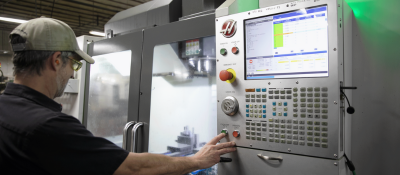Your Cart is Empty

How to Select the Right Air Compressor for a New Plant
Selecting a new air compressor can be difficult, but Rogers is here to help. It is the perfect time to solidly assess the requirements to select the right air compressor type and size that is critical to your plants manufacturing process. This article will discuss how to select the best air compressor for your needs.
Are you responsible for selecting the air compressor for a new facility? It is the perfect time to solidly assess the requirements with no pre-existing limitations of older facilities. Selecting the right air compressor type and size are critical to the manufacturing process in your new plant. Since there are many different types and sizes of compressed air systems to select from for new plants, in this article, we discuss how to select the best air compressor that meets your facility’s needs.
- Why is compressed air system selection so important?
- How do we define the air compressor specifications?
- What are the capacity and pressure requirements?
- What elevation/atmospheric pressure will the compressor operate in?
- Do we need an oil free air compressor or an oil lubricated air compressor?
- What type of cooling is needed?
- What are the power requirements?
- What are the different types of air compressors?
Why is Compressed Air System Selection so Important?
Compressed air is commonly known as the fourth utility in the manufacturing facility, but unlike the three other utilities – electricity, natural gas and water – compressed air cannot be purchased directly from traditional utility companies. Instead, we operate the compressor and treatment equipment that generates the compressed air for the plant’s needs. Other integral components of a compressed air solution include:
- Compressed air treatment equipment – cycling, non-cycling refrigerated, heatless, heated, blower heated desiccant, heat of compression dryers, etc.
- Controls – start/stop, load/unload, modulating controls, magnetic X-line, soft starters, variable frequency drives, lead/lag, sequencing, etc.

How Do You Select the Right Compressor for a New Plant?
How do we know what compressor size we may need? What is the right type for our application? There are several things that should be considered. The following are some of the basic things to consider when determining the air compressor you may need.
What Are the Capacity and Pressure Requirements?
Capacity and pressure requirements are determined by the air requirements in the plant. Check and calculate the Cubic Feet per Minute (CFM) and Pounds for Square Inch (PSIG) requirements of all the tools and equipment requiring compressed air for plant operation. If those specifications are not available, check with the tool/equipment manufacturers for this information. After the total CFM requirement is obtained, we recommend adding 25% of your requirements for leaks and future expansion. For the pressure, calculate the maximum operating pressure needed for the plant or based on the pressure requirement provided by the tool/equipment manufacturers, then add approximately 20 PSIG for pressure loss due to the distance of the compressor to the point of use, pipe size, turning points, dryer, filters, and other factors.
What Elevation/Atmospheric Pressure Will the Compressor Operate In?
Atmospheric pressure is a critical element in selection of an air compressor because it significantly affects the compressor performance. The elevation and atmospheric pressure are inversely proportional. The higher the altitude, the lower the atmospheric pressure. The lower the atmospheric pressure, the lower the air density. At altitudes above sea level, the compressor needs to work harder to overcome the lower air density.
Below is the table showing the effects of altitude on air compressor performance:

Is an Oil Free Air Compressor or Oil Lubricated Air Compressor Required?
It is also very important to know the compressed air quality requirements, because that will dictate the type of compressor and associated equipment (dryers & filters) selected. Generally, it is not enough to say we need oil free and dry air without specifying the solid particulate, oil aerosol, and water allowed in the system. Oil free and dry air are relative terms. What may be acceptable for one industry may not be acceptable for others, or it may be acceptable at one usage point but it may not be acceptable at others.
Below is the ISO8573-1:2010 table, Specifying the Air Quality for the Compressed Air System. Defining the class the compressed air system requires will help to determine the type of compressor, dryer (dew point) and associated equipment.

Depending on the class of air quality, an oil flooded air compressor may be sufficient, an oil lubricated air compressor may be suitable with treatment, or an oil free air compressor may be required.
What Type of Cooling Is Needed?
There are advantages and disadvantages for both air-cooled and water-cooled systems. However, air-cooled is the most common cooling system for the compressor due to cost and environmental regulations for cooling water. Also, air-cooled systems are commonly used with oil-flooded applications. Air-cooled compressors require a well-ventilated area and a cool source of air for the inlet. However, if the ventilation is restricted and the space is confined, a water-cooled system may be better suited. Water-cooled systems are more commonly used in oil-free compressed air systems. The operation cost of a water-cooled compressor is typically higher than the air-cooled compressor due to the requirement of cooling water and other treatment expenses.
What Power Is Available?
Last but not least is the power, which tends to be overlooked or sometimes assumed (although that is not recommended). Making the wrong assumption will cost more money to make the correction and will delay the operation schedule of the facility. These problems are easily avoidable with little attention. Always verify the voltage and amps required to operate the compressor. Also make sure your existing circuit is adequate for your new compressor.
What Are the Types of Compressors?
Compressors are separated into two major groups, positive displacement and dynamic.
Positive Displacement Compressors
Positive displacement compressors bring in air, trap it, and then reduce its volume mechanically.
Reciprocating Compressors
Reciprocating compressors use a piston driven by a crankshaft to deliver high pressure air. The small size, simple maintenance, and ability to set-up near the point of use are some of the benefits of a reciprocating compressor. Reciprocating compressors are available as oil flooded compressors or oil free compressors, and they are designed to run start/stop, only producing air when needed, which is very efficient.

Scroll Compressors
Scroll compressors use intermeshing spiral scrolls, with one being stationary and the other orbiting in relation to it. Although these compressors are limited in size, they are relatively efficient, oil free air compressors and have low noise levels.

Rotary Screw Compressors
Screw compressors use two mated screws to mechanically reduce the volume of the air. These compressors are typically better for industrial uses, are much more durable, and have a higher performance than reciprocating or scroll compressors. Depending on the application, these are available as oil free air compressors or oil lubricated air compressors.

Dynamic Compressors
Dynamic type compressors, for example centrifugal, use a high-speed rotating impeller to transfer energy to the air. Disadvantages include limited capacity control modulation, specialized maintenance considerations, and high initial costs. These compressors are perfect for larger applications and are designed to be oil free air compressors.

Summary of New Plant Air Compressor Selection Guidelines
These general guidelines will help define requirements for selecting an air compressor for a new plant. Although selection means a lot more than deciding between an oil free air compressor or an oil flooded air compressor, the time invested in defining these requirements will affect plant operating efficiency far down the road. For additional assistance in determining which models will best suit your plant’s requirements, contact Rogers Machinery for expert assistance.
For any questions or comments call us at (503) 639-0808.





